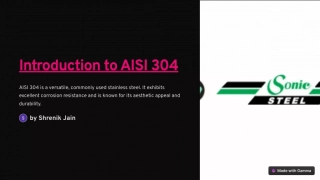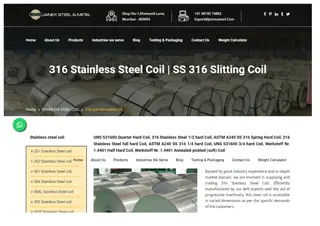
How Pickling of Stainless Steel Improves Metal Durability
nSee how stainless steel pickling boosts corrosion resistance and durability, making it ideal for aerospace, automotive, and other industries.
Download Presentation

Please find below an Image/Link to download the presentation.
The content on the website is provided AS IS for your information and personal use only. It may not be sold, licensed, or shared on other websites without obtaining consent from the author. Download presentation by click this link. If you encounter any issues during the download, it is possible that the publisher has removed the file from their server.
E N D
Presentation Transcript
How Stainless Steel Pickling Works? Key Processes and Benefits Ever wonder why stainless steel pickling is considered so important in industries like automotive and food processing? Pickling, in essence, is an operation intended to ascertain the sturdiness and corrosion resistance of metals, including stainless steel. In old times, acid treatments gained quite a bit of popularity to ensure the corrosion-resistant properties of stainless steel, iron, and other types of metals. Before the 19th century, blacksmiths were applying light vinegar to clean the metals. Since the revolution in chemistry, hydrochloric and nitric acids have been used to remove impurities from metal surfaces. Nowadays, most industries always try to ensure precise cleaning using a welding cleaning machine. Industries like food processing and aeronautics want to ensure optimum levels of cleaning and corrosion resistance to ensure the durability and performance of metals such as stainless steel. This is how safety and functionality are ensured in these organizations. This is not only beneficial for the safety of organizations but also for the safety of workers. Why is picking important for stainless steel? To ensure the durability and functionality of stainless steel, stainless steel cleaner and polish are used. This is how metal resistance is ensured. This process is not only beneficial for metal s durability but also good for the proper functionality of machines. Enhancing Corrosion Resistance and Surface Quality After conducting the welding process, metal gets impure, which requires the pickling of stainless steel to ensure the corrosion resistance of metals. Industries require a proper method of pickling process implementation. This is how the strength and durability of metals can be ensured in industries. Historical Background and Chemical Evolution in Pickling
The pickling of stainless steel is not a new phenomenon; it has its roots in ancient India when people used vinegar and other acid-based materials for metal cleaning. Industrial Revolution: new acids and large-scale Production In the 18th and 19th centuries, during industrial times, nitric and sulfuric acids were used to ensure the durability and functionality of metal surfaces. Time passed, and we used other acids as well, such as hydrochloric acid, to maintain stainless steel s cleanliness and durability. The shift toward safer pickling options With the passage of time, various types of innovation took place in chemical science that provided a variety of pickling and passivation processes of the metals. This is how K2 pickling paste and other stainless steel pickling gel started being applied in the pickling of stainless steel in industries such as food processing, pharmaceuticals, FMCG, and various others. Innovation in eco-friendly techniques Due to innovation in technology, industries have started welding cleaning machines to ensure the use of optimum chemical passivation solutions that enhance the corrosion resistance of metals. The picking process explained Essential chemicals and passive oxide layer formation There are many chemicals that remove impurities from the metals, such as stainless steel, in order to ensure the durability of the metals. Besides the use of acids, some industries may use other materials for example, anti-spatter, water-based, and stainless cleaner and polish to ensure proper pickling for stainless steel. Let us explore the variety of chemicals used in pickling stainless steel. Chemical and tool Purpose Application
Stainless steel pickling gel Helps dissolve the oxide layer Surface pickling Welding cleaning machine Removes welding residue Used post-welding for surface prep Chemical passivation Enhances passive layer After pickling for corrosion solution formation resistance K2 pickling paste Pickling in localized areas spot treatment for weld areas Stainless steel cleaner and ensures cleanliness and Final polish after pickling polish shine Anti-spatter water-based Control adhesion of welding During the welding process spatter After applying the pickling process to stainless steel, a passivation solution is used on the metals to form a protective layer of oxide on the metal that ensures corrosion resistance and provides a durable life. Different pickling methods for stainless steel surfaces Immersion, spray, and paste applications To ensure the pickling of stainless steel, a variety of methods are used to ensure the pickling process of metals. Let us explore all the different types of surface treatments.
Immersion pickling is one of the best pickling methods used in small stainless steel structures in industries, especially on small parts of the machines. Spray pickling is used on larger equipment by applying a solution to the surface. Paste pickling, such as K2 paste and stainless steel pickling gel, is applied to the pickling of stainless steel. Each method of pickling has its advantages and is used as per the requirements of the industries. Key steps in pickling stainless steel Preparation process control and final neutralization There are various steps used in cleaning stainless steel. Let us explore all those processes before starting the practical part of this process. Surface preparation is the first and foremost step in pickling stainless steel to remove impurities from the surface. Choose the best pickling method as per the requirements of the surface. Checking the concentration of chemicals and monitoring surface temperature is a crucial step to get the best results. After pickling is accomplished, the neutralization process of acid takes place for the safety of the surface. This way, the corrosion of stainless steel is controlled to ensure the longevity of the metal surfaces in industries. Applications and Benefits of Pickling in Industrial Maintenance Pickling of stainless steel has become a significant part of many industries to ensure the proper functioning of machines and the quality of products to satisfy the end customers. In addition to this, pickling also helps prepare the surface of metals for further processes such as coatings. Let us understand the advantages of applying the pickling process in industries.
Industry Application Benefits Food and Processing equipment Helps maintain cleanliness beverages Automotive Exhaust systems and engine Provides enhanced durability components Construction Architectural structures Improved longevity and appearance Pharmaceuticals Equipment and storage containers High corrosion resistance Aerospace Aircraft parts Surface preparation for coating To ensure the durability and quality of stainless steel in industries, a pickling process is applied. Conclusion: Enhancing Durability and Performance with Pickling To ensure high-quality metal surfaces in industries, the pickling of stainless steel becomes crucial; however, after the pickling process, chemical passivation also takes place to ensure the formation of an oxide layer that helps prevent corrosion resistance and provides durability. To ensure this process, the application of a high-quality stainless steel pickling gel is unavoidable. T Clean has been able to produce high-quality, non-toxic pickling and passivation gel to ensure optimum performance of stainless steel machines. Visit its website before choosing the best quality pickling gel.
FAQs Q1. What is the pickling process for stainless steel? Ans: The pickling process is applied to stainless steel to remove impurities and oxide layers to ensure the surface is clean and corrosion-resistant. Q2. What is the process of pickling metal? Ans: Immersing, spraying, and using pickling to clean the surface, and thereafter, a neutralization process takes place to control the acid reaction. Q3. What chemical is used in pickling stainless steel? Ans: Hydrochloric and sulfuric acid are the traditional pickling materials, and pickling gel and K2 pickling paste are the modern pickling materials used. For more information - visit us Phone No- +91 7622005114, +91 9924559751 mail us - tcleannvs@gmail.com Address - Plot No. 242,243, G.I.D.C. Kabilpore, Navsari - 396 424 Gujarat, India. Website - Tclean






















